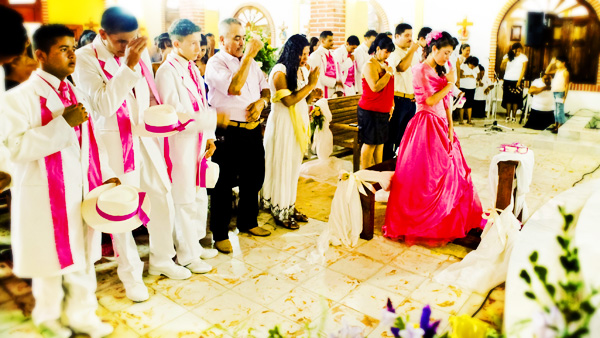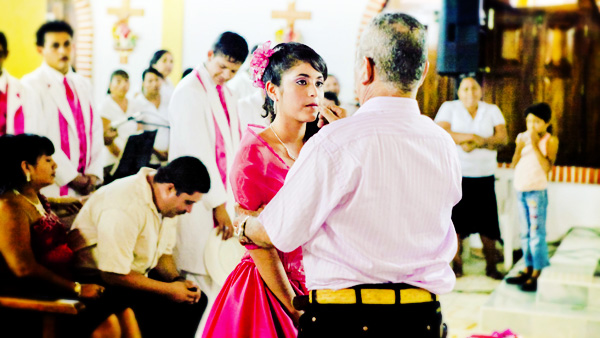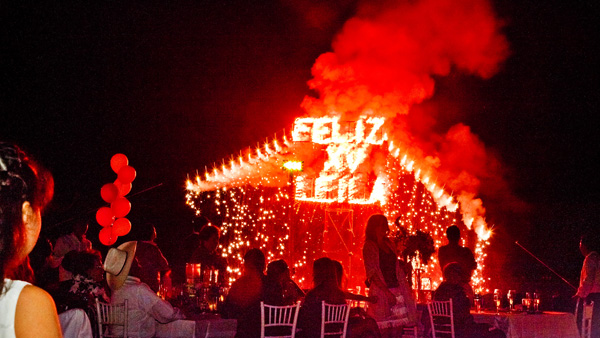For those unfamiliar with the term, a quinceanera is a coming out birthday party for a girl turning 15—a kind of debutante party for one—that is celebrated in almost every country in Latin America. In Mexico, this party can range from strictly traditional to entirely modern, depending on the family involved as well as their economic status, religious beliefs, and other influences.

In our five years here, we have been invited to two quinceaneras. The first was held for our housekeeper’s daughter here in Sayulita, and it was a small-town, traditional event: it began at the church on the plaza with a full-blown thanksgiving mass; the girl, Irma, wore a formal dress, and was accompanied by family as well as her “court of honor,” 14 of her peers—the girls called “Damas,” the boys, “Chambelanes.” All the boys and girls wear formal attire, the girls in elaborate prom-style gowns, the boys decked out with white suits and pink cummerbunds and hat bands. These kids, dressed to the nines, were proud, excited, handsome, and quite a sight to see. It was obvious that it meant a lot to all of them to be a part of it.

After the ceremonies in the church, we paraded several blocks to the big pink party hall that serves as the site for the major Mexican celebrations in Sayulita. Here, a series of ceremonial events took place involving friends and family: Irma danced several waltzes, with her father, with her friends, those dashingly-dressed boys in the court of honor; with her family. She was presented with a tiara, for she is first and foremost a princess; and then, oddly enough to my eyes, her father brought out and solemnly presented her with a pair of high-heeled shoes, on a plush velvet pillow. The shoe business brought to my mind the story of Cinderella, but in this case, the high heels are meant to represent the transition for girl to woman.
This rather elaborate, carefully-planned series of events took well over an hour, perhaps two. Afterwards, we all ate copiously from huge platters of good Mexican food, and drank plenty of beer.

Then a band came on to play. A banda, with multiple horns, guitars, keyboards, drums, and singers. They had a bristling array of microphones and a wall of amplifiers, and when they began to play, the music was so painfully loud that everyone at my table—the gringo contingent—had to leave immediately, rapidly, so as not to have our eardrums blown out. It was shockingly loud, and to this day I can not imagine how several hundred people, grandmothers and babies included, could sit in that room, as spacious as it was, and listen to that infernal racket until three o’clock in the morning. But that’s what they did, and do at many major social events in these parts. I’m glad I don’t live on that street.

The other Quinceanera was celebrated for one of my daughter’s friends. These more privileged kids attend a private school in Puerto Vallarta, and many of them come from families that are fairly wealthy, mostly bilingual and bi-cultural, and not particularly traditional in their mores or values. But our daughter’s friend’s mother is enough of a traditionalist—or her mother is—to have wanted this Quinceanera. And so—we drove to the Westin Hotel in Marina Vallarta, where we spent the evening on a seaside patio with a hundred or so well-off Mexicans and a few gringos like us, eating American food and drinking American wine and chatting about international economics, the surf this week, and our wonderful children. The parents made speeches about their splendid daughter, who is indeed a wonderful girl, and thanked us all for coming. Then the dad, my friend Saeed, danced with his lovely, sweet, 15-year old daughter, to honor her coming of age. After that, as the night rocked on we all danced to a DJ spinning tunes. At one point came a flurry of fireworks, including a tower with flaming letters that spelled Feliz XV Leila, but aside from that, it felt not like a ceremonial event but like a good party at a fun beachfront location. No shoes were presented, and no handsome young men in white suits were on the scene.

This was a far cry from the local, traditional event at the Sayulita church, but still, it served its purpose as a coming out party, affirming Leila’s emergence as a young woman. In both cases, as ex-pat Americans, we were honored to have been invited to these two very different parties, each celebrating a significant day in the life of a Mexican teenage girl.


